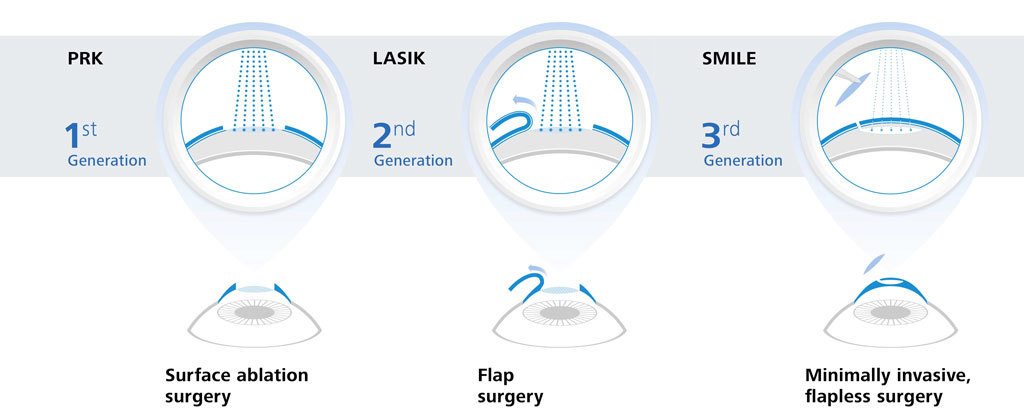What Are The Distinctions And Similarities Between SMILE Eye Surgical Procedure And LASIK And PRK?
What Are The Distinctions And Similarities Between SMILE Eye Surgical Procedure And LASIK And PRK?
Blog Article
Authored By-Fischer Sander
If you've been taking into consideration SMILE eye surgery, you may wonder exactly how it compares to LASIK and PRK. Each procedure has its very own set of benefits and considerations. From quicker recovery times to possible risks, there are key differences you must know prior to making a decision. Comprehending these differences will certainly help you make an educated selection that straightens with your certain needs and expectations. Curious to recognize more concerning how these procedures compare thoroughly? Keep on exploring to acquire a comprehensive understanding of SMILE, LASIK, and PRK.
SMILE Eye Surgery Summary
If you're thinking about SMILE eye surgical procedure, you'll find it to be a minimally intrusive treatment with a fast recuperation time. During SMILE (Little Cut Lenticule Removal), a laser is used to develop a tiny, precise incision in the cornea to get rid of a tiny item of cells, reshaping it to correct your vision. This differs from LASIK, where a flap is developed, and PRK, where the outer layer of the cornea is totally gotten rid of.
One of the essential advantages of SMILE is its minimally intrusive nature, causing a faster healing procedure and less pain post-surgery. The healing time for SMILE is fairly fast, with several people experiencing enhanced vision within a day or more. https://average-cost-of-lasik-per75310.liberty-blog.com/26667835/enhancing-visual-clearness-via-advanced-laser-eye-treatments makes it a preferred selection for those looking for a hassle-free and effective vision correction treatment. Additionally, SMILE has been shown to have a lower risk of dry eye syndrome compared to LASIK, making it a desirable option for individuals worried regarding this possible adverse effects.
Differences Between SMILE, LASIK, and PRK
When contrasting SMILE, LASIK, and PRK eye surgical procedures, it is necessary to recognize the unique methods used in each procedure for vision adjustment.
SMILE (Tiny Incision Lenticule Removal) is a minimally intrusive procedure that involves developing a small incision to remove a lenticule from the cornea, improving it to deal with vision.
LASIK (Laser-Assisted Sitting Keratomileusis) entails producing a thin flap on the cornea, making use of a laser to reshape the underlying tissue, and then repositioning the flap.
PRK (Photorefractive Keratectomy) removes the external layer of the cornea prior to improving the tissue with a laser.
The major difference depends on the method the cornea is accessed and treated. SMILE is flapless, making it a good alternative for people with slim corneas or those involved in contact sporting activities. LASIK offers rapid aesthetic recuperation because of the flap development, yet it may position a higher danger of flap-related complications. PRK, although having a much longer recovery period, stays clear of flap-related concerns altogether.
Recognizing these variations is crucial in selecting the most ideal treatment for your vision adjustment requirements.
Pros and Cons Contrast
To evaluate the benefits and downsides of SMILE, LASIK, and PRK eye surgical procedures, it's necessary to consider the specific benefits and potential restrictions of each procedure. SMILE surgery supplies the advantage of a minimally invasive treatment, with a smaller laceration and possibly quicker recuperation time contrasted to LASIK and PRK. It additionally reduces the risk of completely dry eye post-surgery, an usual adverse effects of LASIK. Nonetheless, cataract surgery when do i need it may have limitations in treating greater levels of myopia or astigmatism compared to LASIK.
LASIK surgery provides rapid aesthetic recovery and very little pain throughout the procedure. It's very effective in dealing with a vast array of refractive errors, consisting of myopia, hyperopia, and astigmatism. Yet, LASIK carries a risk of flap issues, which can impact the corneal framework.
PRK eye surgical procedure, while not as preferred as LASIK, stays clear of developing a corneal flap, reducing the threat of flap-related problems. It's suitable for people with slim corneas or irregular corneal surfaces. Nevertheless, PRK has a longer recovery time and might involve extra discomfort during the recovery procedure.
Conclusion
So, when it involves picking in between SMILE, LASIK, and PRK, think about it like picking the best set of footwear. SMILE resembles a smooth, comfortable pair of sneakers - quick and very easy.
LASIK is more like stylish high heels - flashy and quick, but with some possible threats.
PRK is like tough treking boots - reputable and long lasting, but requiring a bit more effort and time.
Inevitably, the very best choice depends on your individual demands and preferences.
